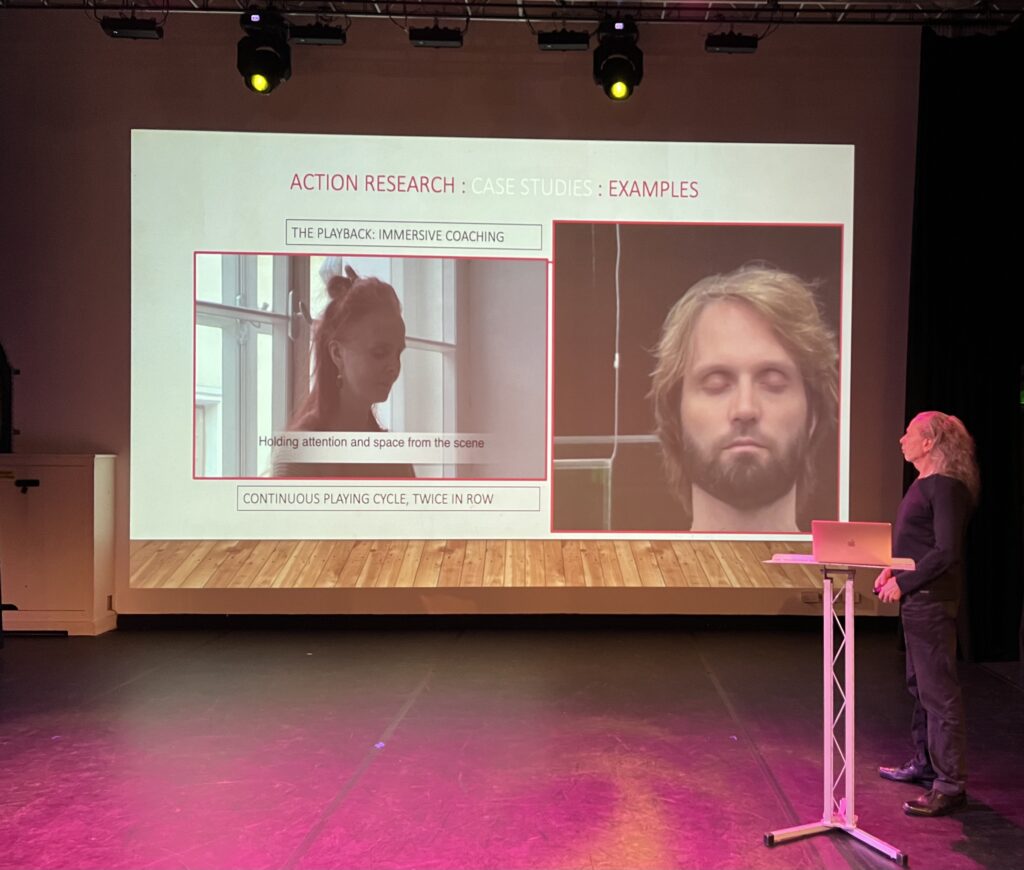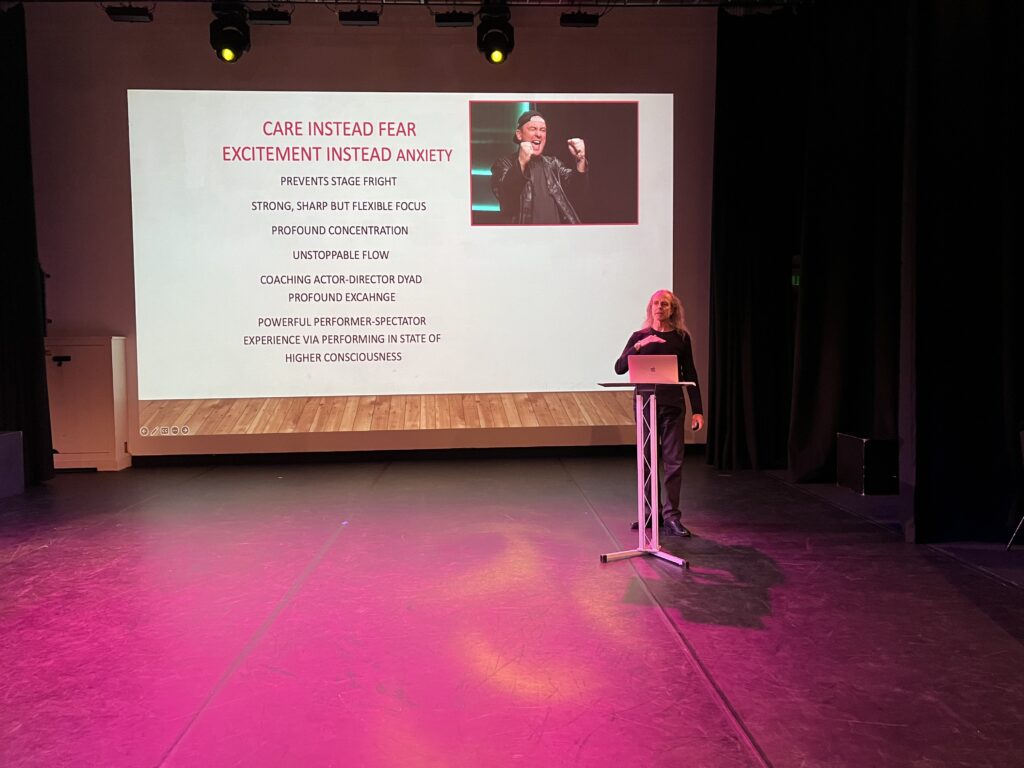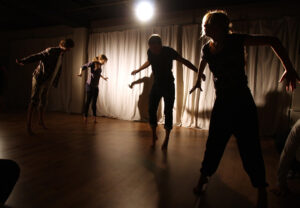Zero Zone in Stanislavski's Teaching
Tamur Tohver's talk @Stanislavsky and Mindfulness symposium, London South Bank University, 2023
Via Stanislavskian craft, one can experience absolute sincerity and higher consciousness, which replaces the internal and external confrontation with fruitful creative outcomes in a rehearsal studio and prevents stage fright, but only if practised perfectly. For this, Stanislavski’s unpublished book “Ethics” sets some principles similar to Vedic Abhyāsa and Vairāgya.[1]
_________________
[1] Abhyāsa means a continuing effort to attain and maintain one’s physical, mental and spiritual tranquillity: practice. Vairāgya means letting go of worldly attachments, fear, paranoia, ego, a false sense of superiority or inferiority, and things beyond human control. Shortly- in Yogic practice, Abhyāsa is understood as practice/training and the right attitude, Vairāgya as detachment via the observer’s position.
Practice
However, in daily practice, many students understand the truthful physical improvisation – Active Analysis – often later via personal kinaesthetic and perceptual insight. Before that happens, it is mainly understood as creating patterns of justified actions. Therefore, the teacher can only hold the student in flow through continuous exercising and coaching until the insight occurs and creates an experience. When the consciousness records the pattern of the situation with its mental, physical and perceptual actions for the new character in concrete circumstances, it sets these as a goal for the next time to be able to repeat the experience if recalled. Thereby, the performer can re-invoke similar bodymind behaviour in the same quality as the one from the past. But Stanislavski aimed to create a new one, similar but original, for every night. That’s why I suggest it’s not reincarnation but incarnation. This could be achieved via solid willpower, profound concentration and belief in the character’s aims, consciously and subconsciously. Since the actor’s body was itself the obstacle in acting, Stanislavski also encouraged the actor to overreach the physical senses.[1] Furthermore, for him, concentration is a perceptual tool which helps to synchronize the spiritual and physical dislocation between body and soul that actors experience.[2]
Thereby, the whole sophisticated process is clearly driven by perceptual but also spiritual qualities. Carnicke and White confirm Stanislavski defended spiritual character creation and message delivery on a superconscious level.[3] This could be complicated to understand in a dualistic materialistic worldview but completely normal with a monistic spiritual and mindful approach.
Thereby, the attitude becomes a new instrument in craft, the belief into higher realisation. Unfortunately, the attitude also seems to be a subject which remained incompletely consolidated with concrete techniques by him.
____________
[1] White, The Routledge Companion, p.287.
[2] White, The Routledge Companion.
[3] Carnicke, Stanislavsky: Uncensored and Unabridged, p. 24-27; White, The Routledge Companion, p.294-295.
Source
According to White, the primary written source of information about yogic practices for Stanislavski were Yogi Ramacharaka’s books.[1] Unfortunately, his writings are not based on authentic yogic wisdom from scriptures, proven by time and plentiful human experience as it appears he never addresses the first two most important limbs of yoga, Yama and Niyama. [2] Yamas and Niyamas are the elements of yogic Abhyāsa and Vairāgya principles,[3] which could not be abandoned in practice. Abhyāsa means continuing effort to attain and maintain one’s physical, mental and spiritual tranquillity: practice. Vairāgya means letting go of materialistic attachments, fear, paranoia, ego, and a false sense of superiority or inferiority. On the simplest level, Vairāgya is accepting the present without anticipation, anxiety, fear, desire, longing, expectations, or preference, as these empower ego. The ego acts as a self-defence mechanism against the ‘not-good-enough’ critique by trying to avoid unpleasant experiences and evokes preventive measures.[4] Therefore, believing in the ego causes suffering through artificial self-limitation.[5]
_________________
[1] White, The Routledge Companion.
[2] More specifically – Yama principle is understood as social observances: codes of conduct, and Niyama is principle of personal observances: codes of discipline in Vedic philosophy and Yoga practice.
[3] These are Yoga core principles, which set the stage for practices that lead to control of the mind and Self-realisation, see Vaid and Pal, “Yogic intervention”; Manek, “Yogic Practices”; Wallis, Tantra Illuminated; Bryant, The Yoga Sutras.
[4] The same schema appears in the dynamics of stage fright (Gabbard,1979).
[5] Wallis, Tantra Illuminated, p.93.
Balance
So, in terms of balance, one can trace the clear prints of Abhyāsa in Stanislavski’s Ethics, but little about exercising detachment, associated anxiety, evaluations, achievement or prejudgments. However, detachment from fear, egoistic goals[1] and ability to regulate one’s emotions enhances the artistic outcome and helps maintain individual balance. He articulates elements of a supporting commitment and practice, which today are mostly interpreted as discipline and passion. Yet, discipline[2] and detachment are different qualities, leading to different results. It seems, Stanislavski didn’t explain the detachment need, as the last feels like the opposite activity to flow creation. Likewise, although he stresses that the director needs to gain the respect of the ensemble to lead the process and that the best way to earn such respect is by personal example, unfortunately, he does not directly emphasise the need for the director’s self-cultivation or special leadership training. It follows that in case the director is not able to gain authority in the team, they could oppress actors.
________________
[1] Not to be confused with the quality of final artistic outcome.
[2] He was in love with discipline, according to his sister Z. S. Sokolova (from foreword of Ethics (1952), p. 5).

Stage Fright
Stanislavski’s weakness in acting was memory – he had a problem remembering his lines, and thereby, he was affected by tremendous stage fright. I suggest the problem was not so much in the amount of text or bad memory, but in how to create an organic connection between the memory, text and actions. According to Merlin 2016, he also felt abandoned by the director. Thus, Stanislavski looked to secure a performing flow to use it uninterruptedly; thereby, his method turns the author’s lines into the performer’s ideas to create this missing bridge. If performers are unable to manage their frightening thoughts and somatic reactions, then the feedback loop between the primary task (the character’s aim in a scene) versus disturbing beliefs (am I sufficient in my doing?) may continue to increase until anxiety reaches the level of panic attacks. On the other hand, as say Thomson and Jaque 2020, if the absorption is strong enough, it allows the performer to release the excessive mental control, and this keeps them perfectly in a performing flow, as there is only one main task to execute.[1] One experiences autotelic transformation of creativity beyond personal evaluation. This, in turn, alleviates anxiety that has emerged.[2] Norvelle (1962) confirms that through concentration while on the stage Stanislavski overcame stage fright: when he ceased (decided not) to be afraid of the audience, “he was on the stage” (in the performing flow).[3]
____________
[1] Thomson and Jaque, “17 – Performing Artists”, p. 290
[2] Thomson and Jaque, “Multifaceted self-consciousness”.
[3] Norvelle, “Stanislavski Revisited”, p.31
Yoga
was introduced to Stanislavski before he reviewed his personal acting methodology in crisis in 1906, in Finland.[1] Yoga provides to Stanislavski the needed grounding knowledge and insights for his future techniques. In 2016, Tcherkasski proved over forty percent of the exercises in Stanislavski’s system originate from various elements of Raja Yoga.[2] Shevtsova 2019 and Magnat 2023 confirm Stanislavski’s aspiration toward the horizontal relationship in ensemble and that yoga practice was important in the First Studio.[3]
____________
[1]Benedetti, Stanislavski: An Introduction.
[2] Examples include the relaxation of muscles (muscular release), the emission and reception of ‘rays’, the beaming of auras, the sending of prana, attention, visualisations (mental images), Tcherkasski, Stanislavsky and Yoga.
[3] The First Studio was the actor training studio of the Moscow Art Theatre. Shevtsova, Rediscovering Stanislavsky, 2019, p. 113
Stanislavski’s Ethics
In 1944, the Moscow Art Theatre publishes in its yearbook Stanislavski’s article Ethics.[1] Ethics was the summary of recognitions from practical work to support practitioners by achieving purity. The article is a version of one of the chapters from The Actor: Work on Oneself.
However, Stanislavski removed this chapter because he considered the subject so vital that he intended to dedicate a separate issue to it. Ethics contains significant grounding for the necessary attitude to practice performing art. Stanislavski emphasises there the need for personal self-cultivation, individual purities and training. Every actor must develop their creative willpower and technique, remember their soul and prepare both the pre-work and condition for the stage; build resilience, ethics, and discipline in oneself that are essential to a social figure who brings beauty, sublimity, and nobility to the world. At the same time, the whole environment should be spiritually cleansed as an immaculate mental space transfers to spectators, attracts and purifies them. He rightfully underlines that only the director knows what effort, ingenuity, patience, nerves and time it takes to move actors of lazy creative will from inertia, which exaggerates the other actors’ play manners. However, he also admits that the director could become overly demanding and easily irritated if they do not get the desired result from the actors. Today, this approach could subconsciously appear or be interpreted as director-centred, giving them seemingly unlimited power over the actors without regarding them as equal partners (Tohver, 2022).[2]
_______________
[1] In 1944, the Moscow Art Theatre publishes in its yearbook Stanislavski’s article ‘Ethics’. This is based on the manuscript of sixty-seven pages of handwritten paper. The article is probably a version of one of the chapters from ‘The Actor: Work on Oneself’. In 1947, the Moscow Art Theatre Museum’s published edition of the same work.
[2] See more in ’Zero zone in Stanislavski’s practice’, Tohver, 2022.

Connection
Now, it is essential to recognise that no yogic manuscript ever does present Abhyāsa or Vairāgya as a standalone practice; they always appear together. Through these two core principles, a person can gain control over their bodymind and securing the outcome by applying the right attitude and high ethics; it’s not just an abstract desire to evoke personal change. Therefore, the subtraction of these principles also creates setback in a result. People without Abhyāsa lack consistency in practising techniques, and thereby, they never reach the goals, described by Vairāgya because it is demanding. Detachment from unneeded habits and withdrawal from negative emotions requires willpower, the profound perceptual distinction skill and exercising. In turn, without having a passion for the aims of Vairāgya, the training loses its sense. Therefore, only together will these two be complete.
In regular practice, one acquires the right attitude, ensuring that the improved skills will be used ethically and sustainably. Most importantly – the method alleviates one’s ego.
Malpractice
There is evidence from both international and my own experience that hidden destructive emotional threats could lead to an unconscious self-protective or autocratic attitude, evoked by a false sense of superiority or inferiority if malpractice the Stanislavskian craft in a mishandled rehearsal process. Thus, contrary to his aspirations, the misinterpretation of mutual responsibilities cultivates the hierarchical relationship prevalent to the present day if one leaves out the first part about the director’s self-cultivation need and applies only the second: the director’s demand toward actors. Likewise, if one dismisses the need for the actor’s self-cultivation, the director’s frustration becomes somehow justified.
Thus, we have carefully to review Stanislavski’s unique method, which inherits all possibilities for perfect realisation, uplifting both creative exchange and personal self-cultivation without dismissing any part of it. Attitude is the key. This reminds me of coaching. The director can consciously create a shared horizontal rehearsal space by taking the coach’s role alongside their creative task.
I call it cultivating directing.
Zero Zone praxis
In my search to create such an elevated exchange, I developed a new methodology called Zero Zone praxis, to be practised between the actor and the director at rehearsals. Alongside case studies over two years and a second production using ZZ praxis in January this year at the Staffordshire University; at the beginning of this month, at the University of Central Florida, the first MFA degree was defended by a professional actress using ZZ praxis at daily practice, in rehearsal and at show time over one season and with three different types of productions. This thesis precisely measured the actor’s preparation, rehearsal and performance process against each of Csikszentmihalyi’s conditions for Flow. I am happy to say her thesis found ZZ praxis profoundly endorses the demands of creating or improving the performing flow.













